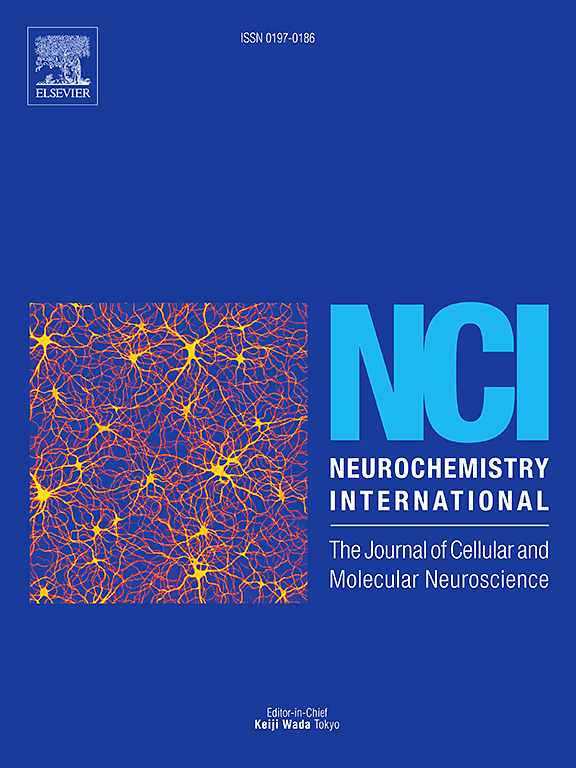Refinement of TSLP expression mediates chronic allodynia associated with IL22/STAT3 axis
IF 4
3区 医学
Q2 BIOCHEMISTRY & MOLECULAR BIOLOGY
引用次数: 0
Abstract
Chronic allodynia is a painful response to an innocuous stimulus because of maladaptive neuroplasticity within the central nervous system. IL22 is a pleiotropic mediator owing to its proinflammatory and immunosuppressive effects. In this study, we aimed to investigate the potential of modulating TSLP expressions to treat chronic allodynia and elucidate the underlying mechanisms associated with IL22. TSLP−/− mice were generated, and four mouse groups were created as follows: wild-type (WT) + PBS, TSLP knockout (KO) + PBS, WT + bleomycin, and TSLP KO + bleomycin. Repeated bleomycin administration reduced the IL22/STAT3 pathway to trigger chronic allodynia in C57BL/6 mice. The degree of gliosis and neuron loss were significantly greater in the somatosensory cortex and spinal cord dorsal horn of the bleomycin-treated mice compared with those in the PBS-treated mice. Compared with those in WT mice treated with bleomycin, in TSLP-deficient mice, the degree of gliosis and neuron loss were significantly lower in the somatosensory cortex and spinal cord dorsal horn and the mechanical withdrawal threshold was altered. Differentiated human SH-SY5Y cells were created to investigate the neuroprotective effects of TSLP refinement against hydrogen peroxide (H2O2)-induced neurotoxicity. The deficiency of TSLP protected differentiated SH-SY5Y cells against H2O2-induced neurotoxicity. IL22 stimulator not only rescued the H2O2-induced neurotoxicity but augmented the protective effect of si-TSLP on differentiated SH-SY5Y cells. Our data confirmed that a lack of TSLP decreased the expression of TSLPR/STAT5, the bleomycin-induced chronic allodynia and the H2O2-induced neurotoxicity. In addition, inhibiting TSLP rescued the IL22/STAT3-mediated effect, which regulated neuroglial interactions to relieve chronic allodynia. Targeting TSLP/TSLPR is a potential therapeutic approach for relieving chronic allodynia by regulating gliosis, neuron loss, and the IL22/STAT3 axis.

TSLP表达的改善介导与IL22/STAT3轴相关的慢性异常性痛
慢性异常性疼痛是由于中枢神经系统的神经可塑性不适应而引起的对无害刺激的疼痛反应。由于其促炎和免疫抑制作用,IL22是一种多效介质。在这项研究中,我们旨在研究调节TSLP表达治疗慢性异常性疼痛的潜力,并阐明与IL22相关的潜在机制。生成TSLP−/−小鼠,并创建四组小鼠:野生型(WT) + PBS, TSLP敲除(KO) + PBS, WT +博来霉素,TSLP KO +博来霉素。在C57BL/6小鼠中,反复给予博来霉素可降低IL22/STAT3通路触发慢性异位性疼痛。与pbs组相比,博莱霉素组小鼠体感觉皮层和脊髓背角的胶质细胞增生和神经元丢失程度显著增加。与博来霉素处理的WT小鼠相比,tslp缺陷小鼠体感觉皮层和脊髓背角的胶质细胞增生程度和神经元损失明显降低,机械戒断阈值发生改变。建立分化的人SH-SY5Y细胞,研究TSLP精制对过氧化氢(H2O2)诱导的神经毒性的神经保护作用。缺乏TSLP可保护分化的SH-SY5Y细胞免受h2o2诱导的神经毒性。IL22刺激剂不仅可以挽救h2o2诱导的神经毒性,还可以增强si-TSLP对SH-SY5Y分化细胞的保护作用。我们的数据证实,缺乏TSLP会降低TSLPR/STAT5的表达、博莱霉素诱导的慢性异常性疼痛和h2o2诱导的神经毒性。此外,抑制TSLP恢复了IL22/ stat3介导的作用,其调节神经胶质相互作用以缓解慢性异常性疼痛。靶向TSLP/TSLPR是一种通过调节胶质细胞增生、神经元丢失和IL22/STAT3轴来缓解慢性异位性疼痛的潜在治疗方法。
本文章由计算机程序翻译,如有差异,请以英文原文为准。
求助全文
约1分钟内获得全文
求助全文
来源期刊

Neurochemistry international
医学-神经科学
CiteScore
8.40
自引率
2.40%
发文量
128
审稿时长
37 days
期刊介绍:
Neurochemistry International is devoted to the rapid publication of outstanding original articles and timely reviews in neurochemistry. Manuscripts on a broad range of topics will be considered, including molecular and cellular neurochemistry, neuropharmacology and genetic aspects of CNS function, neuroimmunology, metabolism as well as the neurochemistry of neurological and psychiatric disorders of the CNS.
 求助内容:
求助内容: 应助结果提醒方式:
应助结果提醒方式:


